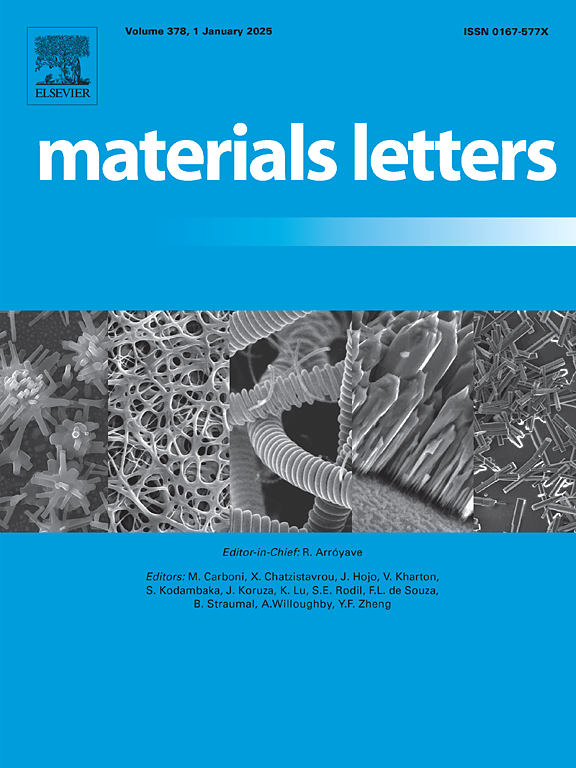Structural, optical, magnetic, and photocatalytic properties of multi-transition metal (Ni, Cu, Co, Fe)-doped ZnO nanomaterials
IF 2.7
4区 材料科学
Q3 MATERIALS SCIENCE, MULTIDISCIPLINARY
引用次数: 0
Abstract
A low-temperature-assisted co-precipitation approach synthesized NixCuxCoxFexZnO nanomaterials. Structure investigation confirmed the integration of Ni, Cu, Co, and Fe into the ZnO lattice, with Size-Strain Plot quantification of crystallite size and microstrain. EDS showed a consistent distribution of all elements, whereas morphological studies showed a shift from quasi-spherical to well-defined hexagonal structures as dopant concentration increased. UV–Vis absorption spectra showed d-d transitions, indicating Fe3+ and Co2+ in ZnO lattice. Magnetic study demonstrated a doping-dependent increase in paramagnetic behavior, suggesting transition metal ion exchange. Photocatalytic tests showed that the Ni0.025Cu0.025Co0.025Fe0.025ZnO sample degraded approximately 100 % of RhB in 60 min under UV light. These results suggest multi-transition-metal-doped ZnO nanoparticles could be used in photocatalysis, optoelectronics, and magnetic materials.
多过渡金属(Ni, Cu, Co, Fe)掺杂ZnO纳米材料的结构、光学、磁性和光催化性能
低温辅助共沉淀法合成了NixCuxCoxFexZnO纳米材料。结构研究证实了Ni, Cu, Co和Fe在ZnO晶格中的整合,并通过尺寸-应变图量化了晶体尺寸和微应变。能谱分析显示,各元素的分布一致,而形态研究表明,随着掺杂浓度的增加,结构从准球形向明确的六边形转变。紫外可见吸收光谱显示d-d跃迁,表明ZnO晶格中存在Fe3+和Co2+。磁性研究表明,顺磁性行为的增加依赖于兴奋剂,提示过渡金属离子交换。光催化实验表明,在紫外光下,Ni0.025Cu0.025Co0.025Fe0.025ZnO样品在60 min内降解了约100%的RhB。这些结果表明,多过渡金属掺杂ZnO纳米颗粒可以用于光催化、光电子和磁性材料。
本文章由计算机程序翻译,如有差异,请以英文原文为准。
求助全文
约1分钟内获得全文
求助全文
来源期刊

Materials Letters
工程技术-材料科学:综合
CiteScore
5.60
自引率
3.30%
发文量
1948
审稿时长
50 days
期刊介绍:
Materials Letters has an open access mirror journal Materials Letters: X, sharing the same aims and scope, editorial team, submission system and rigorous peer review.
Materials Letters is dedicated to publishing novel, cutting edge reports of broad interest to the materials community. The journal provides a forum for materials scientists and engineers, physicists, and chemists to rapidly communicate on the most important topics in the field of materials.
Contributions include, but are not limited to, a variety of topics such as:
• Materials - Metals and alloys, amorphous solids, ceramics, composites, polymers, semiconductors
• Applications - Structural, opto-electronic, magnetic, medical, MEMS, sensors, smart
• Characterization - Analytical, microscopy, scanning probes, nanoscopic, optical, electrical, magnetic, acoustic, spectroscopic, diffraction
• Novel Materials - Micro and nanostructures (nanowires, nanotubes, nanoparticles), nanocomposites, thin films, superlattices, quantum dots.
• Processing - Crystal growth, thin film processing, sol-gel processing, mechanical processing, assembly, nanocrystalline processing.
• Properties - Mechanical, magnetic, optical, electrical, ferroelectric, thermal, interfacial, transport, thermodynamic
• Synthesis - Quenching, solid state, solidification, solution synthesis, vapor deposition, high pressure, explosive
 求助内容:
求助内容: 应助结果提醒方式:
应助结果提醒方式:


